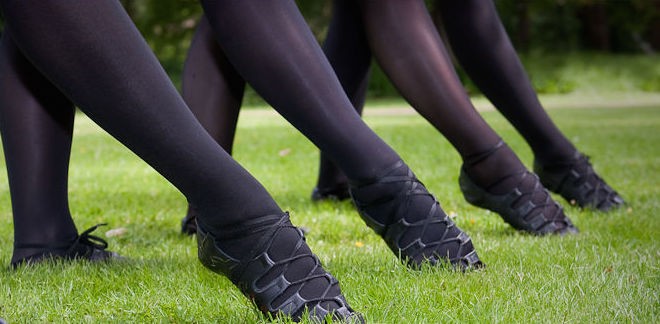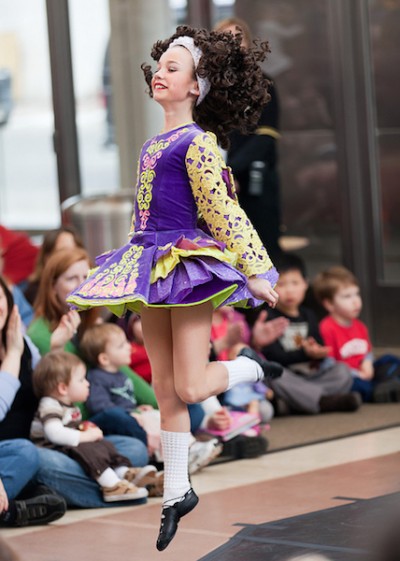Traditional Irish step dance is an extremely technical dance form – I’ve heard Irish dance described as nothing if not technique. I don’t agree completely — Irish dance is rhythm and tradition as well — but the technical aspects of the form are hard to deny.

While much of the technique for Irish dance is similar to ballet, some of the skills do conflict and for some students could prove counter-productive. If you’re considering adding Irish dance training to your dance toolkit, it’s a good idea to explore these differences and consider the benefits (or consequences) of taking up Irish dance in addition to your other dance training.
Here are some of the major differences between Irish dance and concert dance forms:
Posture
Correct posture in Irish dance may seem similar to that of ballet, but is actually quite different.
While Irish dancers must support their core like ballet dancers, they dance with their ribs open and shoulders completely back. This can be one of the most frustrating crossover problems for ballerinas and Irish dancers because the concept of “knitting your ribs” is such a hard one for students to grasp. This posture problem is equally trying for Irish dance teachers – getting well-trained ballet students to open their ribs and squeeze their shoulder blades together while still engaging their core is tough work.

Knees
Another major difference in technique is the use (or lack of use) of plié in Irish dance.
Irish dancers strive to keep their heels off the floor and their legs as straight as possible even when landing from jumps and traveling across the floor. Because Irish dancers spend hours training their feet and legs to support this extreme technique, getting Irish dancers to plié in ballet class becomes the bane of the ballet teacher’s existence.
Turnout
Though Irish dancers work in a turned out position and learn to engage the same turnout muscles as dancers of other forms, the placement of certain positions is significantly different in Irish dance. Fifth position, for example, is ‘overcrossed’ from the perspective of a ballet dancer. All extension happens from fifth position, and is therefore crossed as well.
Irish dancers do not pass through or use a passé in turnout, and ‘parallel’ is not a position that exists in Irish dance. Irish dancers learn to engage their turnout muscles and push across their bodies.
Though training in Irish dance alongside ballet or modern training can sometimes confuse dancers, there are benefits to being proficient in both.
Cardio
While many dancers struggle to get enough cardiovascular exercise during class, Irish dancers rarely have this problem. Irish dance is incredibly athletic, and requires dancers to move at a very fast pace for extended periods of time. Every movement in Irish dance requires one’s feet to leave the floor so Irish dancers are, literally, hopping for entire class periods. If a dancer needs more cardio exercise and running or swimming just won’t satisfy, Irish dance can be a creative alternative.
Strength
Irish dance builds strength where dancers need it most. Because Irish dancers dance on the toes, they have the incredible foot, ankle, and lower leg strength that students of other forms sometimes struggle to build. This strength is evident when ballet dancers move to pointe. My Irish/ballet dancers are usually dancing in pointe shoes a full year before their non-Irish-dancing peers.
Irish dancers also build core control and strength in large muscle groups. Because they develop fast twitch muscle fibers to jump constantly, Irish dancers generally love the petite and grand allegro sections of ballet class and generally excel at them.
Musicality
The most important aspect of Irish dance is rhythm and timing. My first Irish dance teacher used to say, “If your dancing doesn’t sing the song of the music, you aren’t Irish dancing.” Understanding of the music and the connection between movement and music are integral to even the most rudimentary Irish dance class. Of course, musicality is integral to ballet, but dancers who take Irish dance alongside other forms may develop musical skills faster or beyond that of their non-Irish-dancing peers.
Irish dance draws movers from many different backgrounds. Some dancers take up Irish dance for cultural reasons, for the intense technical training involved, or, yes, as a supplement to other forms of dance.
I can’t say whether Irish dance will help or hinder your other dance training. There are clearly many factors to consider. Hopefully this article gives you some information about what you might encounter as a dancer who wants to do both and help you come to your own conclusion.
For me, learning Irish dance alongside my traditional ballet training meant I had to dance smarter and understand the differences between the two forms. But, training in Irish dance and ballet made me a unique and versatile dancer, and ultimately added to my professional career.
Carlye Cunniff is a professional dancer and dance educator based in Seattle, Washington. She currently co-directs and dances in the Seattle Irish Dance Company, teaches all around the city and writes about all things dance.

Dance Advantage welcomes guest posts from other dance teachers, students, parents, professionals, or those knowledgeable in related fields. If you are interested in having your article published at Dance Advantage, please see the following info on submitting a guest post. Read posts from guest contributors.

